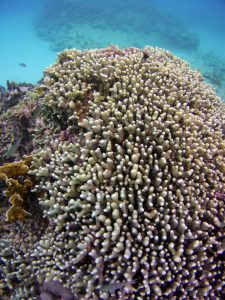
A healthy colony of Porites porites on the Vauxhall reef, Barbados. P. porites is one of the species found susceptible to stony coral disease in Florida
Stony coral tissue loss disease, first reported in Florida in 2014, is moving quickly according to a report in Science News and has reached the US Virgin Islands; view:
A mysterious coral disease is ravaging Caribbean reef
BY CASSIE MARTIN 6:00AM, JULY 9, 2019 on Science News
It is also affecting deeper water corals:
Holstein is using ocean current data and other factors to forecast where the disease might show up next. Early results suggest that another U.S. Caribbean territory, Puerto Rico, should be worried. Divers in May confirmed that the outbreak is inching toward the Puerto Rican island of Vieques, with star corals about 17 kilometers offshore and 40 meters deep already pocked with white lesions, says Tyler Smith, who oversees the reef monitoring program at the University of the Virgin Islands in St. Thomas.
The discovery was disheartening, Smith says. Scientists knew that star corals in shallower waters were susceptible to the disease, but hoped those living in deeper waters might be spared.
According to info on a website for the Florida Department of Environmental Protection, Stony Coral Tissue Loss (SCTL) Disease Response, nearly half of Florida’s 45 reef-building coral species have reportedly been affected including:
(* indicates a species listed under the Endangered Species Act):
Agaricia agaricites (Lettuce coral)
Agaricia fragilis (Fragile saucer coral)
Colpophyllia natans (Boulder brain coral)
Dendrogyra cylindrus (Pillar coral)*
Dichocoenia stokesii (Elliptical star coral)
Diploria labyrinthiformis (Grooved brain coral)
Eusmilia fastigiata (Smooth flower coral)
Meandrina meandrites (Maze coral)
Montastraea cavernosa (Great star coral)
Madracis decactis (Ten-ray star coral)
Mycetophyllia spp. (Cactus coral)*
Orbicella annularis (Lobed star coral)*
Orbicella faveolata (Mountainous star coral)*
Orbicella franksi (Boulder star coral)*
Porites astreoides (Mustard hill coral)
Porites porites (Clubtip Finger Coral)
Pseudodiploria strigosa (Symmetrical brain coral)
Pseudodiploria clivosa (Knobby brain coral)
Siderastrea radians (Lesser starlet coral)
Siderastrea siderea (Massive starlet coral)
Solenastrea bournoni (Smooth star coral)
Stephanocoenia intersepta (Blushing star coral)Some of the most susceptible species have disappeared from certain long-term monitoring sites, however there are still surviving colonies of those species across the Florida Reef Tract. There has been a decline in the population of some species.
Among the most susceptible species are Dendrogyra cylindrus (pillar coral) which is listed as threatened under the Endangered Species Act, Dichocoenia stokesii (elliptical star coral), and Meandrina meandrites (maze coral). Some of the most important reef-building species have also been affected, including Colpophyllia natans (boulder brain coral), Montastraea cavernosa (great star coral) and Siderastrea siderea (massive starlet coral), among others.
So these are species to keep an eye on in Barbados.
